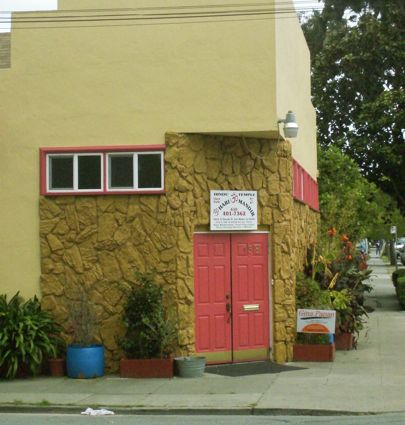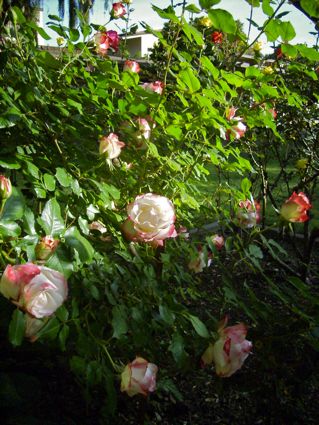The summertime morning fog has begun rolling in again. I came vaguely awake early this morning as a morning bus turned the corner at the traffic light below our bedroom. The light was dim and diffuse, and I knew that the fog was hanging a few hundred feet over San Mateo, blocking the sun. There’s cold water welling up from the depths of the Pacific on the other side of the Coastal Range,. It’s making a huge fog bank every morning, and every morning some of that fog drifts inland. In San Francisco, and on the coast side of the hills to the west of us, the fog might be at ground level, but here in downtown San Mateo it hangs above us as low clouds. I love the summertime morning fog. By mid-day, the fog will disperse, exposing us to the relentless California sunshine, and most afternoons the San Mateo Gale will start whipping through town. But summer mornings are dim and cool.
Category: Places
Hindu temple
There’s an amazing diversity of places of worship within walking distance of where we live in San Mateo. Here’s the local Hindu temple, about six blocks away:
Link to a photo of Masjid Ul Haqq from a few months ago.
The joys of a San Francisco summer
Summer is upon us in the Bay area, and it is time to reflect again on Mark Twain’s description of Bay area summers:
Along in the summer, when you have suffered about four months of lustrous, pitiless sunshine, you are ready to go down on your knees and plead for rain — hail — snow — thunder and lightning — anything to break the monotony — you will take an earthquake, if you cannot do any better. And the chances are that you’ll get it, too.
Summer
At lunch time, I drove down to the marshes at Baylands Nature Preserve. A baby American Avocet stood at the edge of the water swishing its tiny beak back and forth to gather insects and other invertebrates from the water, just like the adult avocets a few yards away. Out in deeper water, a Mallard hen watched carefully over two baby Mallards swimming on either side of her. I couldn’t help noticing the difference in the way the two species raise their young: the American Avocet is a precocial species whose young are on their own from hatching, while the Mallard is an altricial species whose adults care for their babies for some time. It seemed that everywhere I looked I saw birds nesting or getting ready to nest: Cliff Swallows building their nests of clay on the side of a building, Forster’s Terns apparently nesting on a tiny island in the middle of the marsh, Marsh Wrens warbling madly in the rushes.
I looked across the bay at the green hills of the East Bay. Except some of the lower hills at the far end of the Dumbarton Bridge don’t look all that green any more. It’s been warm for the past few days, and it looks like the rains are finally over and gone, and now some of the low hills are turning summer-brown. The higher hills and mountains are still brilliant green, but it won’t be long before they turn brown, too.
Baby birds and hills turning brown: these two markers in time are as good as any to mark the end of the winter-wet season, and the beginning of the summer-dry season.
Roses in Palo Alto
Pollen
Here in the Bay Area, we had two or three weeks of rainy, cool weather last month, and all the trees and flowers just sat there in their little plots of ground, waiting. Then it got warm, and all the trees and flowers started to release their pollen again. Except by that time they were behind schedule, and besides they were feeling cranky that they had had to wait so long to release their pollen (because after all the weather is supposed to be perfect here all the time, and even the trees and flowers get cranky when the weather isn’t perfect), and besides that we have had more rain than usual this year and all the plants are feeling frisky, and so the trees and flowers decided to double their pollen output. And my head is stuffed up, and I can’t breathe, and the over-the-counter allergy pills I take don’t work, and I feel even spacier than usual because my whole head is filled with pollen, not brains but pollen.
I can’t wait for summer when everything will dry out and all the plants will turn brown and wither and go dormant.
Near San Juan Bautista
Late winter:
for Roger’s
fiftieth
birthday I
bought two books,
put them on
the kitchen
table. There
they sat, next
to the bills
waiting to
be paid, the
candlesticks,
the tea pot,
and Carol’s
laptop. There
they still sit.
The sun is
higher, the
trees across
the street have
leaves, the bills
have mostly
been paid. The
days flow past
every one
demanding
attention:
eat, sleep, shit,
wash dishes,
water the
garden, and
early spring:
the two books
are still on
the kitchen
table, next to
the tea pot,
and the sun-
light, and us.
for Roger’s birthday, since we didn’t give him the books
Disaster preparedness for congregations
Recently, I’ve been thinking about disaster preparedness for our congregation here in Palo Alto. Fortunately, here in the Bay Area the odds are extremely low for blizzards, ice storms, typhoons or hurricanes; and tornadoes are rare (although we did have one tornado watch this part year). So I don’t have to worry about whether the steeple is going to blow down in a hurricane, as we had to in Massachusetts; nor do I have to know where the storm cellar is, as we had to in Illinois. But we do have to prepare for some potential disaster scenarios.
Two of the more common Bay area disasters shouldn’t worry us much in Palo Alto: we’re on the flats so we don’t have to worry about landslides, and we are far enough from the Bay that tsunami risks are low. However, our buildings are at some risk for flooding: we are in Flood Zone X, which is defined as “an area of moderate risk of flooding (roughly speaking, outside the 100-year flood but inside the 500-year flood limits).” Thus, while we should be paying attention to flooding, it’s not of the highest priority.
Our highest priority for disaster preparedness is, not surprisingly, earthquakes. The USGS “Shaking Map for Future Earthquake Scenarios” (click on the map for Mountain View) shows that our location, because of underlying soils, etc., could be expected to experience very strong to violent shaking (Mercalli Instensity VIII-IX) in an earthquake like the magnitude 7.9 1906 San Francisco earthquake. In other words, it could be bad, and we should be paying attention to preparing for this kind of disaster. So at the moment, I’m reading through the USGS publication “Putting Down Roots in Earthquake Country”.
I’d be curious to know if your congregation has disaster plans in place, and what preparations you have made. Feel free to hold forth in the comments.
Spring
I was walking across the patio at the church this morning. Suddenly, smoke swept across the far side of the patio. Was someone burning brush? No, it wasn’t smoke — it didn’t smell like smoke, and it wasn’t blue — it must be dust. But the only way you’d get a dust cloud like that would be if it were very windy, and there was nothing more than a gentle breeze blowing.
Then I looked up. One of the trees in the patio, a non-native tree, some kind of European conifer, was releasing huge clouds of pollen, so much pollen that it looked like smoke.



